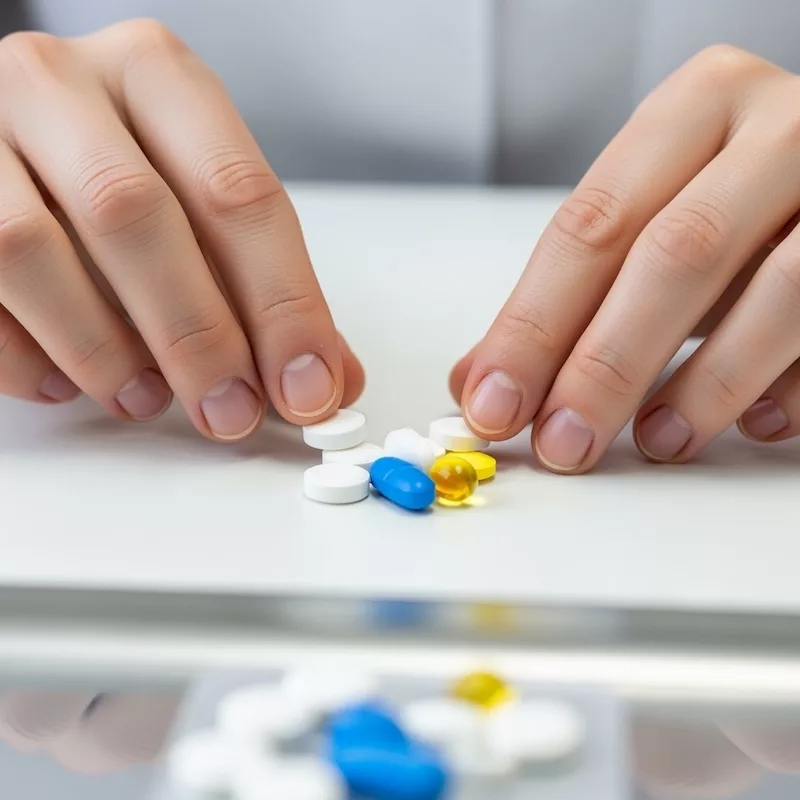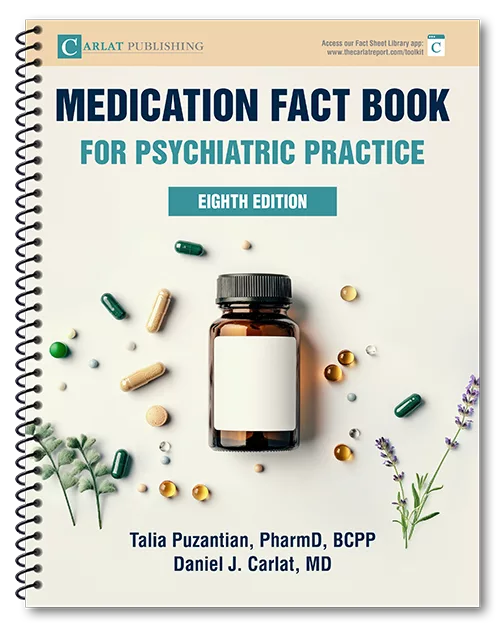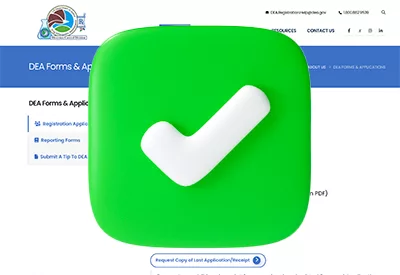Lithium, pramipexole, bupropion, carbamazepine, valproate, and trazodone. Meds that require special skill to start:
Publication Date: 09/22/2025
Duration: 17 minutes, 27 seconds
Transcript:
KELLIE NEWSOME: Lithium, pramipexole, bupropion, carbamazepine, valproate, and trazodone. These are our final meds that require special skill to start: Welcome to the Carlat Psychiatry Podcast, keeping psychiatry honest since 2003.
CHRIS AIKEN: I’m Chris Aiken, the editor-in-chief of The Carlat Psychiatry Report.
KELLIE NEWSOME: And I’m Kellie Newsome, a psychiatric NP and a dedicated reader of every issue. We started this series with some sound advice. Ask the patient if they’d rather go fast or slow when titrating a medication. But patients expect us to be the experts, and you need to know where the lines are drawn.
CHRIS AIKEN: That’s what the rest of the series has been about – don’t start above 1 mg with prazosin. Don’t speed up clozapine or lamotrigine, and go extra slow when drug interactions are present. I also lean toward the slow side in the young and adults – those under age 18 or over age 65 or who are medically frail. And when I am unsure of how the medication will affect them – like when the patient has a brain injury or a developmental disorder – these are populations where meds are understudied in those populations and paradoxical reactions abound; those are cases where I will also go slow. Then there are a few meds where we just know that early side effects are likely to be a problem, and that’s what this podcast is about: meds like lithium, pramipexole, and bupropion. At the end, we’ll close with a research update on antidepressant withdrawal. First is bupropion. This antidepressant has a reputation for causing insomnia and anxiety, and I used to get a lot of callbacks about panic on it, but 15 years ago, I learned a trick about bupropion at an APA course, and I’ve not had that problem since. Though the PDR suggests starting buproprion at 150-200 mg a day, try starting lower – 75 mg a day – in anxious patients and raising very slowly, by 75 mg every week. I also use this strategy when starting bupropion in bipolar disorder, which is rare as I don’t use antidepressants much in that illness, especially the bipolar I type. Now, I don’t have proof of this, but I think antidepressants are less likely to disrupt mood in bipolar if they are titrated gradually, and also if they are tapered off gradually. Abrupt physiologic changes – from time zones to childbirth to medications – are common causes of manic switching.
KELLIE NEWSOME: I’ve found the same strategy helpful with topiramate. I haven’t seen as many cognitive problems on this anticonvulsant since I started titrating it really slowly – starting at 25 mg at night and raising by 25 mg every week. I also keep the dose low, preferably around 100mg. This works well because most of the psychiatric conditions that topiramate treats, like binge eating and obesity, are not emergencies, so you have time to raise it gently.
CHRIS AIKEN: Carbamazepine is another one where slower is better. That’s a secret the late Fred Goodwin shared with me. He had seen how the slow titration that lamotrigine required made that anticonvulsant not just safer but better tolerated, so he started titrating carbamazepine slowly as well, starting at 100 mg and raising by 100 mg every 5-7 days. That lead to a lot less dizziness and sedation; however, if they are in acute mania, you should raise it faster. Carbamazepine is also one that induces its own metabolism, so you should expect the levels to drop after 2-3 months on it, at which point you’ll need to raise the dose. If you read the protocols on how to do this, it can sound quite intimidating, getting the serum levels checked after steady state and again at 2 months… imagine getting a manic patient to adhere to that or even check their labs? But don’t sweat it. Remember that serum levels of carbamazepine were developed for epilepsy, not bipolar, so you don’t need to be exact here like you do with lithium, we don't actually know what the exact serum level is for carbamazepine in bipolar. If you use carbamazepine, you’re basically going to dose it by the patient's response. The serum level is only a rough guide. I also start lithium slow – again, the luxury of outpatient work. When I start lithium, my goal is usually long-term prevention, so I’ll start it as slow as the patient needs. Slower if they are afraid of lithium, like 150 mg at night until they are comfortable with it, or even lower using the liquid form. Pramipexole is another one I start low, in depression: 0.125 to 0.25 mg at night and raise by that same amount every 5-7 days. With pramipexole, once you get to 0.75mg, you can raise faster, but going too fast with this one causes a lot of nausea and fatigue. There are also meds where the dosing in the PDR is way too aggressive for everyday practice. Take valproate, Depakote ER. The dose in the PDR is a loading dose, which we use for acute mania on the inpatient unit – where you give 10 times their weight in pounds (or 25 times their weight in kilograms, but I find it easier to remember the pounds formula). But on the outpatient side, the bigger risk is that the patient will stop the medication, so I don't use loading dose much on the outpatient side. Instead, I start it lower, 250 to 500 mg at night, and raise gradually.
KELLIE NEWSOME: We mentioned this problem earlier in the series with antipsychotics – their PDR dosing is also based on hospitalized patients for psychosis and mania. I do not start aripiprazole at 10-15 mg a day like the PDR recommends; I start at 2-5 mg to prevent akathisia. But even with depression, the PDR can edge too high with antipsychotics. They recommend dosing lumateperone (Caplyta) at the same dose as the treating dose: Start at 42 mg and keep it there, in both bipolar depression and schizophrenia. When it first came out, that was the only size available, but a lot of us had trouble with that strategy, and that’s probably why they now make lumateperone in 10.5 and 21 mg doses, which is where I like to start it.
CHRIS AIKEN: Trazodone is another one to raise slowly, at least when you are using it for depression. Is anyone out there using trazodone for depression? Why not – it deepens sleep quality and has little to no weight gain and sexual side effects. It’s supported by a lot of research in all kinds of depression, from severe inpatient to mild outpatient. And it has a unique mechanism, so it might increase the odds of success over switching from, say, sertraline to duloxetine. People give out trazodone left and right for insomnia, but it’s rarely used for depression, and that’s probably because it causes too much fatigue. Not so if you give it all at night, and unless your patient has hypotension on it, most can tolerate trazodone all at night in the antidepressant dose range of 150 to 300. But if you do start using it, you’ll need to know this secret of titration. Trazodone is not just better tolerated but also more effective when it is titrated slowly. The reason is that trazodone produces a nasty metabolite called mCPP, and when mCPP levels spike, it can cause dysphoria, anxiety, even suicidality. When trazodone is raised slowly, its metabolite also moves up slowly, resulting in better outcomes for your patients. Start trazodone at the lowest dose – 50 mg at. night– and raise it by 50 mg every 5-7 days. When you get to 150 mg, let it rest for a few weeks to see if it works. If not, you can raise it slowly again. The dose range for depression is 150-300mg for trazodone.
KELLIE NEWSOME: Here are some psychopharm curiosities. Medications where the starting dose is the same as the treating dose. Those are desvenlafaxine (Pristiq) – start at 50 mg, and most of the time you stay at 50 mg. Paliperidone (Invega). This antipsychotic was originally released and is only available as an ER form. That improves its tolerability so it can be started at the treating dose, 6 mg a day, though you can go higher to 12 mg if needed. When I start these medications, I remind them that this feature is an advantage – starting at the treating dose helps them get better faster, at least in theory.
CHRIS AIKEN: We could also add the opioid blocker, naltrexone here – it only comes as 50 mg, which is also the treating dose, but naltrexone can cause nausea, so I usually ask the patient to cut that pill in half and take it with food at as they start it out. I’m usually prescribing it in alcohol use disorder, where motivation to change and med adherence are not always high. Another one where you tend to start at the treating dose is ondansetron. Used off-label for OCD, this one is very well tolerated. There are a couple of controlled trials supporting it, and you start at 4 mg per day for OCD. All of those trials with ondansetron were done with augmentation.
KELLIE NEWSOME: Let’s end with the most unusual dosing schedule in psychopharmology. There’s one medication that you need to start at a high dose and then lower down. Can you guess it? Disulfiram (Antabuse) for alcohol use disorder. The point of this one is to block the enzyme that gets rid of the hangover-inducing alcohol byproduct, acetaldehyde. So you start disulfiram high, 500 mg per day for a week to quickly block the enzyme, then lower down to 250mg for the long term.
CHRIS AIKEN: But do we have time for a research update?
KELLIE NEWSOME:Yes! It is Incidence and Nature of Antidepressant Discontinuation Symptoms: A Systematic Review and Meta-Analysis by Michail Kalfas and colleagues from JAMA Psychiatry.
CHRIS AIKEN: Antidepressant withdrawal is a big deal. There are patient advocacy groups devoted to it. A few years ago, a New York Times investigation into it went viral. But the research world has been unfazed, and this study furthers the divide between how researchers and patients view this syndrome. The authors analyzed 18 randomized controlled trials that assessed discontinuation symptoms with a standardized rating scale. Compared to placebo, abrupt cessation of antidepressants did lead to withdrawal symptoms, but the effect size was small, equivalent to a single extra item on the rating scale.
KELLIE NEWSOME: I’m almost relieved. But turning back to the New York Times story, I have to contend with Victoria, who tried to stop sertraline after three years on the medicine. “Basically, that’s all I have been doing — dealing with the dizziness, the confusion, the fatigue, all the symptoms of withdrawal.”
CHRIS AIKEN: That’s the first problem with this analysis. They measured withdrawal by number of symptoms, not severity. Many patients only report a single symptom – like dizziness or brain zaps – but it is severe. I had one patient with bipolar disorder who developed brain zaps after stopping fluoxetine. For two years, that was his chief complaint, the brain zaps. Even as he went through mania and mixed states, it was the brain zaps that bothered him most. The other problem with the analysis is that the studies were short-term. On average they only took the antidepressants for 5 months. It’s very rare to see problematic withdrawal at that duration. In contrast, the New York Times estimates that in 2018, 7% of Americans have taken antidepressants for at least five years. 11% have been on them for at least two years.
KELLIE NEWSOME: Yes. In 2015, researchers looked at antidepressant withdrawal in 180 patients who had been on the antidepressant for 3-15 years. 74% of them had withdrawal symptoms.
CHRIS AIKEN: Withdrawal symptoms are more common with short-acting drugs like venlafaxine and paroxetine, but of the 18 trials in this analysis, only one involved paroxetine and none involved venlafaxine. 40% involved meds with few WD risks, like the long-half-life Vortioxetine and the European melatonergic agomelatine, which has no withdrawal symptoms at all. These papers also used standard, research-based doses of antidepressants, but withdrawal problems are more common when patients take higher doses for prolonged periods – as often happens in practice – even though it shouldn’t. With the exception of tricyclics, antidepressants generally do not have a dose-dependent benefit beyond the medium to low range, like 20-40 mg of fluoxetine.
KELLIE NEWSOME: The bottom line. This trial is well designed within a limited range, and within that limited range, it reassures us that antidepressant withdrawal is not a big deal if you’ve been on them for less than 6 months. But if you’re patient has taken them for longer, or used a high dose or a short-acting med, abrupt cessation might cause some trouble. Join the conversation on this and other papers on LinkedIn, Twitter, Facebook, and Bluesky: Search for ChrisAikenMD. Do you have any tips on starting psych meds? Send them to caiken@thecarlatreport.com. You’ll find more dosing secrets in our textbook Prescribing Psychotropics, the book that Nassir Ghaemi calls, "Not only useful, but engaging and entertaining."
CHRIS AIKEN: I’m Chris Aiken, the editor-in-chief of The Carlat Psychiatry Report.
KELLIE NEWSOME: And I’m Kellie Newsome, a psychiatric NP and a dedicated reader of every issue. We started this series with some sound advice. Ask the patient if they’d rather go fast or slow when titrating a medication. But patients expect us to be the experts, and you need to know where the lines are drawn.
CHRIS AIKEN: That’s what the rest of the series has been about – don’t start above 1 mg with prazosin. Don’t speed up clozapine or lamotrigine, and go extra slow when drug interactions are present. I also lean toward the slow side in the young and adults – those under age 18 or over age 65 or who are medically frail. And when I am unsure of how the medication will affect them – like when the patient has a brain injury or a developmental disorder – these are populations where meds are understudied in those populations and paradoxical reactions abound; those are cases where I will also go slow. Then there are a few meds where we just know that early side effects are likely to be a problem, and that’s what this podcast is about: meds like lithium, pramipexole, and bupropion. At the end, we’ll close with a research update on antidepressant withdrawal. First is bupropion. This antidepressant has a reputation for causing insomnia and anxiety, and I used to get a lot of callbacks about panic on it, but 15 years ago, I learned a trick about bupropion at an APA course, and I’ve not had that problem since. Though the PDR suggests starting buproprion at 150-200 mg a day, try starting lower – 75 mg a day – in anxious patients and raising very slowly, by 75 mg every week. I also use this strategy when starting bupropion in bipolar disorder, which is rare as I don’t use antidepressants much in that illness, especially the bipolar I type. Now, I don’t have proof of this, but I think antidepressants are less likely to disrupt mood in bipolar if they are titrated gradually, and also if they are tapered off gradually. Abrupt physiologic changes – from time zones to childbirth to medications – are common causes of manic switching.
KELLIE NEWSOME: I’ve found the same strategy helpful with topiramate. I haven’t seen as many cognitive problems on this anticonvulsant since I started titrating it really slowly – starting at 25 mg at night and raising by 25 mg every week. I also keep the dose low, preferably around 100mg. This works well because most of the psychiatric conditions that topiramate treats, like binge eating and obesity, are not emergencies, so you have time to raise it gently.
CHRIS AIKEN: Carbamazepine is another one where slower is better. That’s a secret the late Fred Goodwin shared with me. He had seen how the slow titration that lamotrigine required made that anticonvulsant not just safer but better tolerated, so he started titrating carbamazepine slowly as well, starting at 100 mg and raising by 100 mg every 5-7 days. That lead to a lot less dizziness and sedation; however, if they are in acute mania, you should raise it faster. Carbamazepine is also one that induces its own metabolism, so you should expect the levels to drop after 2-3 months on it, at which point you’ll need to raise the dose. If you read the protocols on how to do this, it can sound quite intimidating, getting the serum levels checked after steady state and again at 2 months… imagine getting a manic patient to adhere to that or even check their labs? But don’t sweat it. Remember that serum levels of carbamazepine were developed for epilepsy, not bipolar, so you don’t need to be exact here like you do with lithium, we don't actually know what the exact serum level is for carbamazepine in bipolar. If you use carbamazepine, you’re basically going to dose it by the patient's response. The serum level is only a rough guide. I also start lithium slow – again, the luxury of outpatient work. When I start lithium, my goal is usually long-term prevention, so I’ll start it as slow as the patient needs. Slower if they are afraid of lithium, like 150 mg at night until they are comfortable with it, or even lower using the liquid form. Pramipexole is another one I start low, in depression: 0.125 to 0.25 mg at night and raise by that same amount every 5-7 days. With pramipexole, once you get to 0.75mg, you can raise faster, but going too fast with this one causes a lot of nausea and fatigue. There are also meds where the dosing in the PDR is way too aggressive for everyday practice. Take valproate, Depakote ER. The dose in the PDR is a loading dose, which we use for acute mania on the inpatient unit – where you give 10 times their weight in pounds (or 25 times their weight in kilograms, but I find it easier to remember the pounds formula). But on the outpatient side, the bigger risk is that the patient will stop the medication, so I don't use loading dose much on the outpatient side. Instead, I start it lower, 250 to 500 mg at night, and raise gradually.
KELLIE NEWSOME: We mentioned this problem earlier in the series with antipsychotics – their PDR dosing is also based on hospitalized patients for psychosis and mania. I do not start aripiprazole at 10-15 mg a day like the PDR recommends; I start at 2-5 mg to prevent akathisia. But even with depression, the PDR can edge too high with antipsychotics. They recommend dosing lumateperone (Caplyta) at the same dose as the treating dose: Start at 42 mg and keep it there, in both bipolar depression and schizophrenia. When it first came out, that was the only size available, but a lot of us had trouble with that strategy, and that’s probably why they now make lumateperone in 10.5 and 21 mg doses, which is where I like to start it.
CHRIS AIKEN: Trazodone is another one to raise slowly, at least when you are using it for depression. Is anyone out there using trazodone for depression? Why not – it deepens sleep quality and has little to no weight gain and sexual side effects. It’s supported by a lot of research in all kinds of depression, from severe inpatient to mild outpatient. And it has a unique mechanism, so it might increase the odds of success over switching from, say, sertraline to duloxetine. People give out trazodone left and right for insomnia, but it’s rarely used for depression, and that’s probably because it causes too much fatigue. Not so if you give it all at night, and unless your patient has hypotension on it, most can tolerate trazodone all at night in the antidepressant dose range of 150 to 300. But if you do start using it, you’ll need to know this secret of titration. Trazodone is not just better tolerated but also more effective when it is titrated slowly. The reason is that trazodone produces a nasty metabolite called mCPP, and when mCPP levels spike, it can cause dysphoria, anxiety, even suicidality. When trazodone is raised slowly, its metabolite also moves up slowly, resulting in better outcomes for your patients. Start trazodone at the lowest dose – 50 mg at. night– and raise it by 50 mg every 5-7 days. When you get to 150 mg, let it rest for a few weeks to see if it works. If not, you can raise it slowly again. The dose range for depression is 150-300mg for trazodone.
KELLIE NEWSOME: Here are some psychopharm curiosities. Medications where the starting dose is the same as the treating dose. Those are desvenlafaxine (Pristiq) – start at 50 mg, and most of the time you stay at 50 mg. Paliperidone (Invega). This antipsychotic was originally released and is only available as an ER form. That improves its tolerability so it can be started at the treating dose, 6 mg a day, though you can go higher to 12 mg if needed. When I start these medications, I remind them that this feature is an advantage – starting at the treating dose helps them get better faster, at least in theory.
CHRIS AIKEN: We could also add the opioid blocker, naltrexone here – it only comes as 50 mg, which is also the treating dose, but naltrexone can cause nausea, so I usually ask the patient to cut that pill in half and take it with food at as they start it out. I’m usually prescribing it in alcohol use disorder, where motivation to change and med adherence are not always high. Another one where you tend to start at the treating dose is ondansetron. Used off-label for OCD, this one is very well tolerated. There are a couple of controlled trials supporting it, and you start at 4 mg per day for OCD. All of those trials with ondansetron were done with augmentation.
KELLIE NEWSOME: Let’s end with the most unusual dosing schedule in psychopharmology. There’s one medication that you need to start at a high dose and then lower down. Can you guess it? Disulfiram (Antabuse) for alcohol use disorder. The point of this one is to block the enzyme that gets rid of the hangover-inducing alcohol byproduct, acetaldehyde. So you start disulfiram high, 500 mg per day for a week to quickly block the enzyme, then lower down to 250mg for the long term.
CHRIS AIKEN: But do we have time for a research update?
KELLIE NEWSOME:Yes! It is Incidence and Nature of Antidepressant Discontinuation Symptoms: A Systematic Review and Meta-Analysis by Michail Kalfas and colleagues from JAMA Psychiatry.
CHRIS AIKEN: Antidepressant withdrawal is a big deal. There are patient advocacy groups devoted to it. A few years ago, a New York Times investigation into it went viral. But the research world has been unfazed, and this study furthers the divide between how researchers and patients view this syndrome. The authors analyzed 18 randomized controlled trials that assessed discontinuation symptoms with a standardized rating scale. Compared to placebo, abrupt cessation of antidepressants did lead to withdrawal symptoms, but the effect size was small, equivalent to a single extra item on the rating scale.
KELLIE NEWSOME: I’m almost relieved. But turning back to the New York Times story, I have to contend with Victoria, who tried to stop sertraline after three years on the medicine. “Basically, that’s all I have been doing — dealing with the dizziness, the confusion, the fatigue, all the symptoms of withdrawal.”
CHRIS AIKEN: That’s the first problem with this analysis. They measured withdrawal by number of symptoms, not severity. Many patients only report a single symptom – like dizziness or brain zaps – but it is severe. I had one patient with bipolar disorder who developed brain zaps after stopping fluoxetine. For two years, that was his chief complaint, the brain zaps. Even as he went through mania and mixed states, it was the brain zaps that bothered him most. The other problem with the analysis is that the studies were short-term. On average they only took the antidepressants for 5 months. It’s very rare to see problematic withdrawal at that duration. In contrast, the New York Times estimates that in 2018, 7% of Americans have taken antidepressants for at least five years. 11% have been on them for at least two years.
KELLIE NEWSOME: Yes. In 2015, researchers looked at antidepressant withdrawal in 180 patients who had been on the antidepressant for 3-15 years. 74% of them had withdrawal symptoms.
CHRIS AIKEN: Withdrawal symptoms are more common with short-acting drugs like venlafaxine and paroxetine, but of the 18 trials in this analysis, only one involved paroxetine and none involved venlafaxine. 40% involved meds with few WD risks, like the long-half-life Vortioxetine and the European melatonergic agomelatine, which has no withdrawal symptoms at all. These papers also used standard, research-based doses of antidepressants, but withdrawal problems are more common when patients take higher doses for prolonged periods – as often happens in practice – even though it shouldn’t. With the exception of tricyclics, antidepressants generally do not have a dose-dependent benefit beyond the medium to low range, like 20-40 mg of fluoxetine.
KELLIE NEWSOME: The bottom line. This trial is well designed within a limited range, and within that limited range, it reassures us that antidepressant withdrawal is not a big deal if you’ve been on them for less than 6 months. But if you’re patient has taken them for longer, or used a high dose or a short-acting med, abrupt cessation might cause some trouble. Join the conversation on this and other papers on LinkedIn, Twitter, Facebook, and Bluesky: Search for ChrisAikenMD. Do you have any tips on starting psych meds? Send them to caiken@thecarlatreport.com. You’ll find more dosing secrets in our textbook Prescribing Psychotropics, the book that Nassir Ghaemi calls, "Not only useful, but engaging and entertaining."


_-The-Breakthrough-Antipsychotic-That-Could-Change-Everything.webp?t=1729528747)



